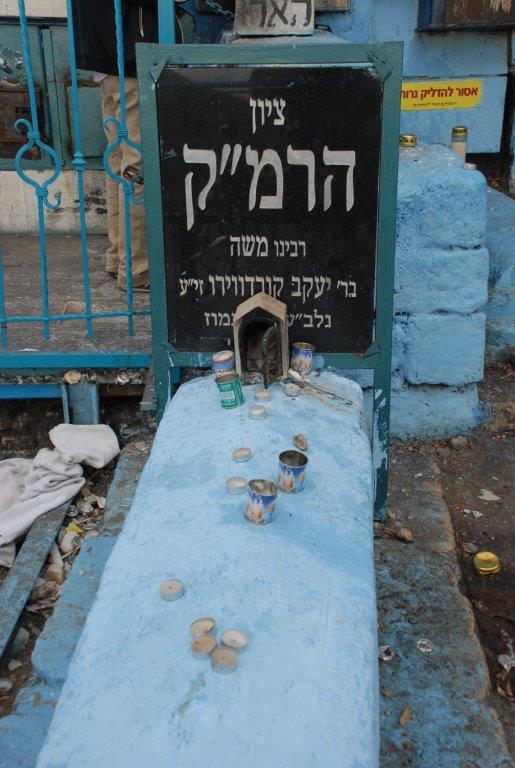JOSEPH CARO (Spain 1488-Tzfat 1575)
Rabbi Joseph Caro succeeded where others before him tried and failed. He gave the Jewish people an organized and universally accepted code of law. In his first book, “Beit Yosef”, he compiled all the laws and ritual practices from biblical times, as well as rulings and interpretations accumulated over 1,500 years. All these were codified systematically, and accompanied by rulings on divisive issues. The Jewish world received Caro’s Halacha enthusiastically, and his “Shulchan Aruch”, the shortened from of “Beit Yosef”, is the authoritative code of law for traditional Jews to this day.
Joseph Caro was 4 when the Jews were banished from Spain. His family resettled in Turkey, where he spent the next 40 years. He set up a yeshiva in Adrianople and associated with prominent kabbalists like Shlomo Alkabets. He was greatly influenced by Shlomo Molkho, the apocalyptic visionary, and ended up immigrating to the Land of Israel and setting in Tzfat. Here he wrote his monumental work.
Like most of his contemporaries, Caro delved into the Kabbalah. He recorded the revelations of Maggid (angelic voice) which he experienced, in his dairy “Maggid Mesharim”. Many believe that it is only through such divine Supervision that he succeeded in compiling his immensely important work.

Tomb of Rabbi Yosef Caro
SHLOMO ALKABETZ (Adrianople 1500- Tzfat 1583)
Rabbi Shlomo Alkabetz is known primarily for his poem “Lecha Dodi” (Come, my Beloved). This poem, which in the words of Gershom Scholem “fuses mystic symbolism with a messianic yearning for redemption”, is recited to this day by Jews around the world as they usher in the Sabbath.
Alkabetz settled in Tzfat after being inspired by the Kabbalists in his birthplace and adopting their ways. In Tzfat, he set up a “brotherhood” whose members saw themselves as followers in the footsteps of Rabbi Shimon Bar Yochai. They aspired to bring about redemption through acts of repentance. Their involvement in the Kabbalah and their pious customs inspired the creation of additional fellowships of this kind, such as the Ari’s “Lion Whelps”.
Thus did Shlomo Alkabetz set a pattern in Tzfat. He also wrote kabbalistics interpretations of the Psalms and Song of Songs, but these did not become widely known. He lived to an old age and is buried next to other Kabblists in Tzfat’s old cemetery.

Tomb of Rabbi Shlomo Alkabetz
MOSHE CORDOVERO (Tzfat 1522-Tzfat 1570)
Rabbi Moshe Cordovero became known mainly for his systematic approach to the Kabbalah. He studied under Joseph Caro and was member of the brotherhood founded by his brother-in-law Shlomo Alkabetz. His first work “Pardess Rimonim”, was a methodical summary of the different trends in Kabbalah until his time. His genius lay in his ability to organize the vast corpus of earlier literature in a coherent fashion.
Cordovero’s doctrine deals with the bridge between God and man, made possible by the structure of the “sefirotb” (emanations) which radiate from God. The revelation of God to man takes place through the sefirot. A person can tie himself to God by modeling his activities on the spiritual qualities represented by the ten sefirot.
Cordovero was a prolific writer and also achieved widespread fame as a scholar and teacher. He was recognized as the principal master of esoteric studies in Tzfat, at least until the appearance of the Ari, who became Cordovero’s heir.

Tomb of Rabbi Moshe Cordoviro
ISSAC LURIA – THE ARI (Jerusalem 1534- Tzfat 1572)
The Ari was the preeminent Kabbalist of 16th century Tzfat, despite the short period he lived here (1569-1572) and the young age at which he died. Lurianic theology and ritual innovation quickly spread throughout the Jewish world and established supremacy unchallenged to this day.
Luria’s father died when the boy was eight. His mother moved from Jerusalem to Egypt, where he was brought up in the home of his wealthy uncle. From a young age he immersed himself in esoteric studies. He immigrated to Tzfat in 1569 to join the scholars and Kabbalists here and probably also because he believed 1575 would be the year of redemption. In Tzfat he studied Kabbalah with Moshe Cordovero. After the latter’s death Luria, his undisputed heir, gathered around him a circle of scholars, some of them distinguished rabbis. He taught them orally, writing down little of his own kabbalistic system and limiting the number of his disciples. They ewe known as the Ari’s “Gurim” (Lion Whelps). He guarded the secret of his system and did not permit its propagation, becoming celebrated mainly for his conduct and ascetic life.
Issac Luria and his disciples took upon themselves the “tikkun” (restitution) of the upper and lower cosmos so as to bring about the coming of the Messiah. They practiced “Kavanah” (meditation in the act of prayer), penitence and fasting. They studied the Zohar, prayed at the tombs of saintly personages and engaged in charitable deeds. In contrast with the traditional belief that redemption would occur after the Messiah’s arrival, the Ari taught that the task of restitution rests on the entire Jewish people, through strict observance of religious precepts and prayer. Only once Tikkun has been affected will the Messiah’s appearance become possible. These basic concepts are what made Lurianic Kabbalah a “practical Kabbalah”. They prepared the ground for the messianic of the Sabbatean and Hassidic movements.
The Ari died in an epidemic, aged 38. His teachings became known only through the writings of his disciples, particularly those of Haim Vital. Certain allusions they make suggest that Issac Luria was believed to be the “Messiah, son of Joseph”, whose task it was the pave the way for the Messiah, son of David. His untimely death was explained by some of his contemporaries as punishment for having divulged his secrets to Haim Vital.

Tomb of Rabbi Yitzchak Luria Ashkenazi

